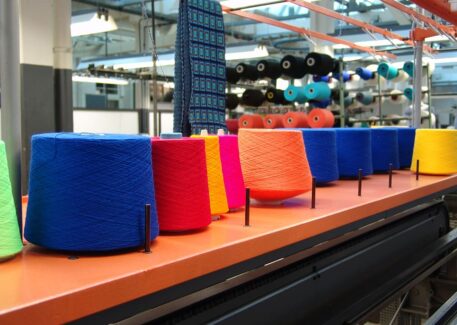
Wastewater treatment of textile industries
Textile wastewater treatment becomes very complicated because there is a great variety in the production of these products and a variety of fibers and colors are used in this work. Sometimes the BOD and COD of this type of wastewater are very high and textile wastewater treatment must be very advanced and accurate to be able to use the effluents of this industry properly and the output of textile wastewater treatment is in line with international standards. It should be noted that the dyes used in these industries can enter the water sources and prevent the penetration of light into the water and disrupt the photosynthesis of aquatic plants and harm human health and the environment in general.
Textile industry wastewater also has a high TDS and its environment is acidic. In general, textile wastewater can be bleached, cleaned, dyed, stabilized, calcined, and various other chemicals diluted. Due to the parts in the production line, the temperature of this wastewater reaches up to 50 degrees Celsius. Each section of the plant has its own wastewater, which will be different depending on the materials used in that section.
The difference between textile wastewater treatment and other wastewaters
Textile wastewater treatment is different from other wastewaters such as municipal wastewater due to the nature of this wastewater, so that in this wastewater BOD is one to 26 percent of COD, while in municipal wastewater this number reaches 50. Bioremediation processes to remove suspended solids in wastewater oxygen are biochemical and these methods have not been used much to remove dyes because the structure of dyes is complex and complex and can not be easily decomposed by biological processes. To start the treatment of textile wastewater, according to the conditions and quality of this wastewater, pre-treatment should be done. Basically, biological processes are much cheaper and easier to treat wastewater. Most dye removal in textile wastewater treatment is done through physical and chemical methods such as coagulation and flocculation and adsorption, reverse osmosis, and the use of membrane filters. Traditional methods of wastewater treatment also have problems. The injection of coagulants used for pre-treatment must be very accurate. This injection is also used for bleaching textile wastewater and if it is not accurate, it can have negative effects. Another disadvantage of these methods is pH control. Sludge produced at the end of the work can also be a waste of time and money and must be sent to special places.
WHAT ARE THE BEST STEPS TO TREAT TEXTILE WASTEWATER?
There are various methods for wastewater treatment, including textile wastewater, the most cost-effective of which is the use of wastewater treatment packages, and as mentioned, biological processes also have a good place among these methods, but new methods and packages combine several processes in industry. Has become common. Textile wastewater is collected from parts of the factory that include initial washing, dyeing and post-dyeing. All these steps indicate high water consumption in this industry. So it can be used again in the industrial cycle by refining. Usually for the treatment of textile wastewater is a common physical, chemical and biological processes. One of the most effective methods of textile wastewater treatment that has been approved by the competent authorities and greatly reduces energy and consumption costs. The first step in this method is physical treatment and the textile waste, which contains fibers and lint, is separated by occupiers. The next step is different in different packages and if a coagulant is used, it will be difficult, but there is a method that will separate the ions at the anode and cathode by electrical decomposition, and using this method, the dye will be separated from the wastewater. It is based on the fact that hydrogen gas will be separated at the anode and at the cathode of the coagulant will be attached to chemical contaminants and removed from the wastewater. After these steps, we reach biological purification, which usually uses aerobic purification by MBBR method, which means aerobic purification with growth adhering to the moving bed.

Work Scope
Aquaquark Engineering and Construction Company is ready to provide water and industrial wastewater treatment services in Textil industries by using modern and optimal treatment solutions.
- Financial Responsibility to Our Clients
- Superior Quality and Craftsmanship
- Quality and Value to the Projects We Deliver
- Highest Standards in Cost Control
